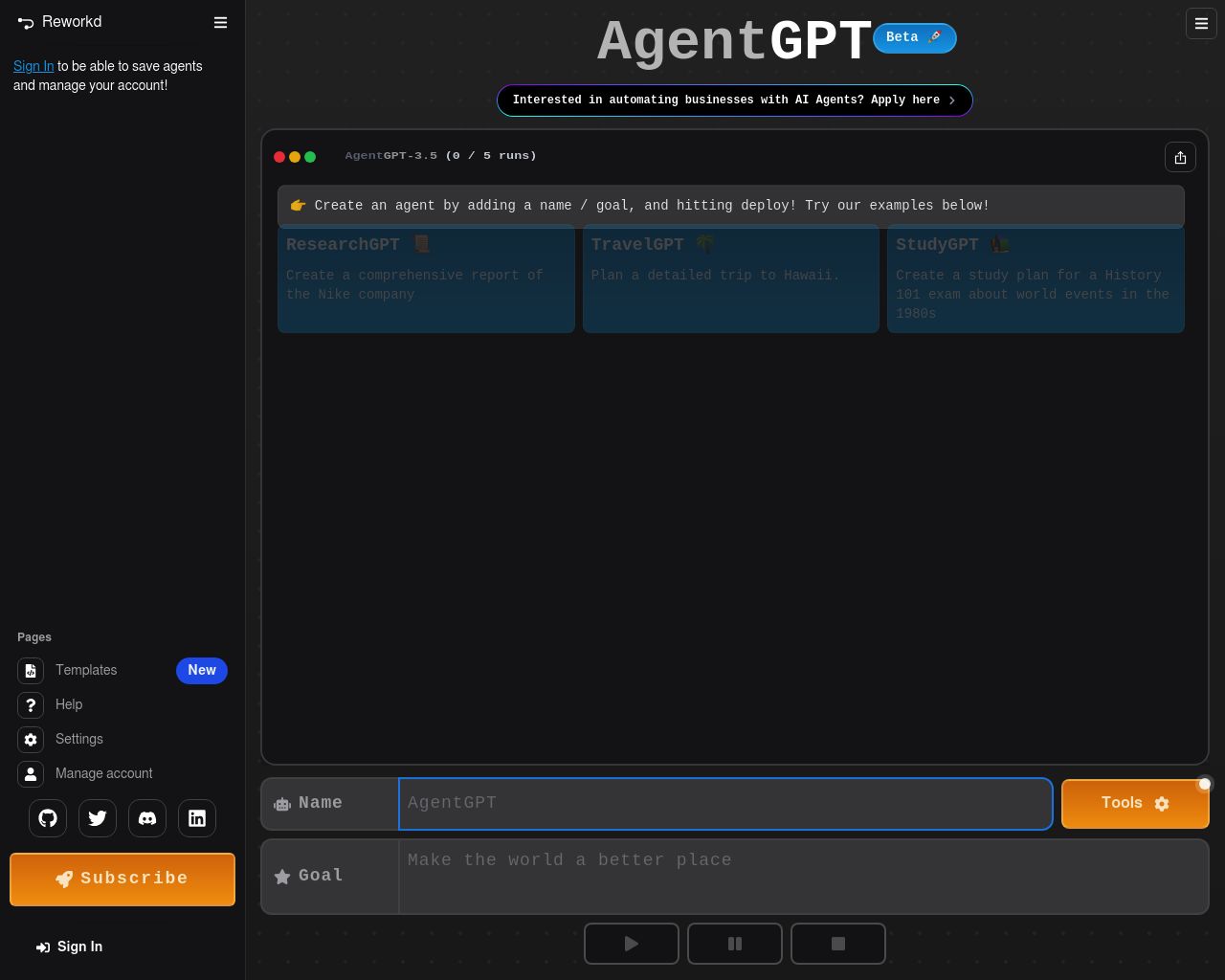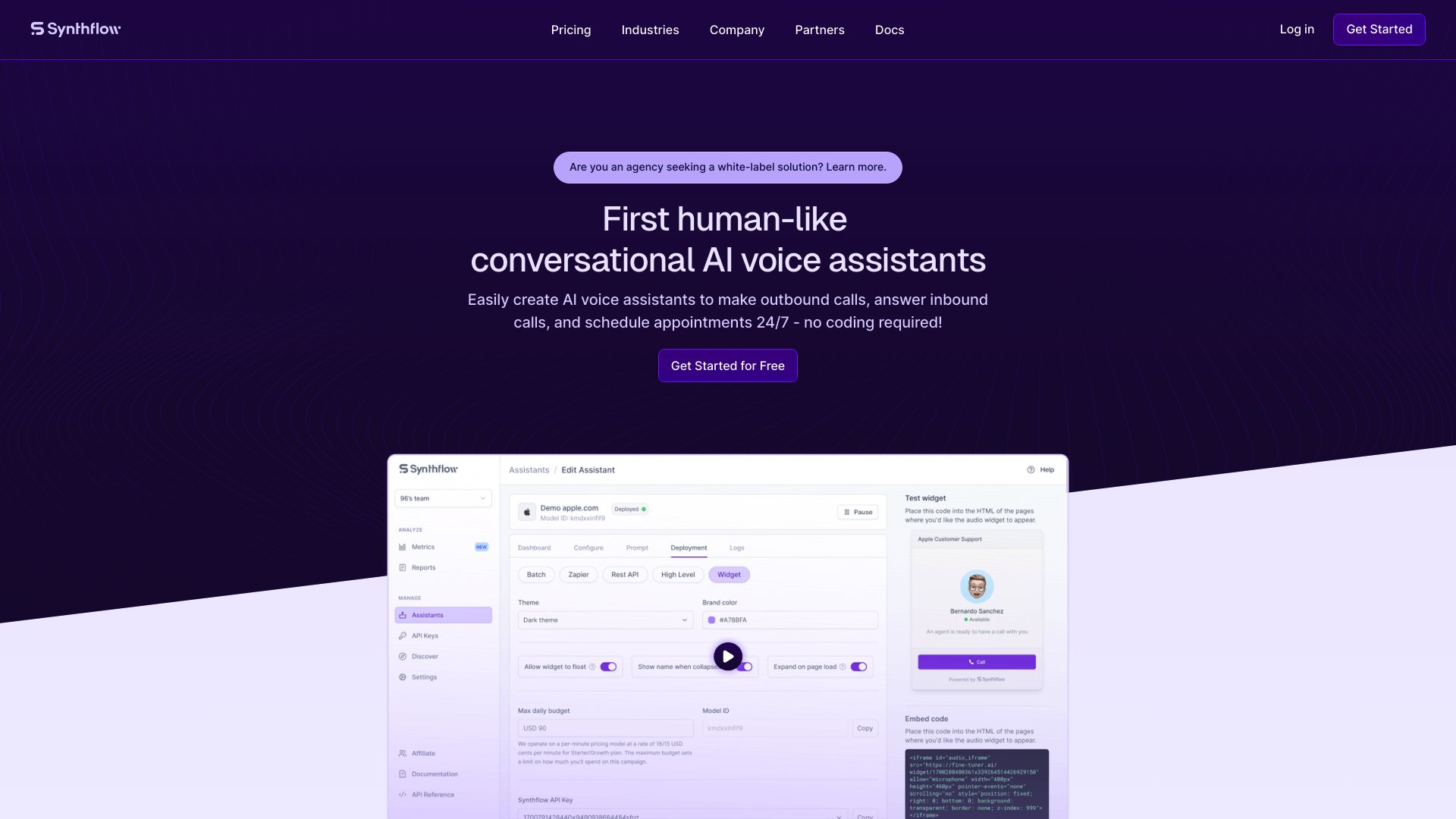AgentGPT vs. Synthflow: Comparing AI Agent Platforms
AI agents are transforming how businesses automate tasks, process data, and engage customers. This review compares two leading platforms — AgentGPT vs. Synthflow — examining their capabilities, strengths, and limitations. AgentGPT empowers developers to build autonomous web-based AI agents, while Synthflow enables creation of customized AI voice assistants without coding. We’ll explore how each platform approaches agent development, deployment options, and key features.
For developers and technical teams, we’ll dive into API integrations and advanced AI capabilities. Business leaders will gain insights on scalability, security, and enterprise readiness. Non-technical users will learn about no-code tools and pre-built templates. By the end, you’ll understand which solution best fits your AI ambitions and technical requirements.
AgentGPT Overview
AgentGPT empowers developers to create and deploy autonomous AI agents in a web environment. Unlike conversational AI, these agents tackle broad, goal-oriented tasks with independence. The platform offers user authentication, agent run saving and sharing, multi-language support, and AI model customization.
Vector databases enhance AgentGPT’s memory management, allowing agents to retain execution history and access long-term information. This feature boosts their ability to handle complex, extended tasks effectively. The platform scales efficiently through its cloud offering and integrates seamlessly with tools like LangChain, making it suitable for both individual developers and larger teams.
AgentGPT empowers developers to create and deploy autonomous AI agents in a web environment. Unlike conversational AI, these agents tackle broad, goal-oriented tasks with independence.


AgentGPT streamlines web data extraction, automating the entire process from website scanning to data output. This automation significantly reduces time, costs, and complexities associated with data extraction, making it a valuable tool for businesses aiming to optimize their operations.
While AgentGPT offers powerful features for AI agent development, it lacks some advanced capabilities. The platform doesn’t provide a visual builder or no-code editor, which may limit accessibility for non-technical users. Additionally, there’s no explicit mention of features for explainability, transparency, or debug modes, which could be crucial for complex AI implementations.
Despite these limitations, AgentGPT’s focus on autonomous agents, memory management, and scalability positions it as a robust option for developers and businesses looking to harness AI for task automation and data processing. Its open-source nature also encourages community contributions, potentially leading to ongoing improvements and innovations.
Synthflow Overview
Synthflow empowers businesses to create customizable AI voice assistants without coding expertise. The platform’s no-code interface and pre-built templates make AI technology accessible to users with varying technical backgrounds.


Synthflow’s AI assistants handle diverse tasks, from customer support to lead generation and appointment scheduling. The platform prioritizes data privacy and security, offering unlimited secure storage in a dedicated Pinecone environment. Integration with tools like 11Labs and Twilio enhances functionality, allowing users to deploy AI agents that align with their brand identity.
Synthflow empowers businesses to create customizable AI voice assistants without coding expertise. The platform’s no-code interface and pre-built templates make AI technology accessible to users with varying technical backgrounds.
The platform’s batch deployment capabilities support large-scale communication campaigns, while real-time interaction is facilitated through website widgets. Synthflow provides comprehensive documentation and support, helping users maximize the platform’s potential.
While Synthflow excels in creating voice-based AI assistants, it lacks some advanced features found in other platforms. The absence of a debug mode, multi-agent collaboration, and specialized deployment options like webhooks or scheduled agents may limit its applicability for complex AI projects. Additionally, the platform does not offer extensive data handling capabilities such as PDF or Word file support.
Synthflow’s vision centers on democratizing AI technology, aiming to streamline business operations and enhance customer engagement across various industries. By providing a user-friendly platform for AI assistant creation, Synthflow positions itself as a valuable tool for businesses seeking to leverage AI without extensive technical resources.
Feature Comparison
AgentGPT and Synthflow offer distinct approaches to AI agent development, with notable differences in their core components and security features. AgentGPT focuses on autonomous AI agents for web environments, while Synthflow specializes in customizable AI voice assistants.
AgentGPT’s strengths lie in its autonomous agent capabilities and memory management using vector databases. This allows agents to retain execution history and tackle complex, extended tasks effectively. However, AgentGPT lacks a visual builder or no-code editor, which may limit accessibility for non-technical users. The platform also doesn’t offer explicit features for explainability, transparency, or debug modes.
In contrast, Synthflow provides a no-code interface with pre-built templates, making AI technology more accessible to users without coding expertise. Synthflow prioritizes data privacy and security, offering unlimited secure storage in a dedicated environment. However, Synthflow lacks some advanced features like debug mode, multi-agent collaboration, and specialized deployment options such as webhooks or scheduled agents.
Both platforms have gaps in their security features compared to SmythOS. While AgentGPT and Synthflow offer some level of data protection, they lack comprehensive security measures like constrained alignment, advanced encryption, and IP control that SmythOS provides. SmythOS also outperforms both in terms of deployment flexibility, offering options to deploy as API, webhook, site chat, scheduled agent, and GPT, which are not explicitly mentioned for AgentGPT or Synthflow.
Feature Comparison Table
| AgentGPT | Synthflow | SmythOS | |
|---|---|---|---|
| CORE FEATURES | |||
| Visual Builder | ❌ | ✅ | ✅ |
| No-Code Options | ❌ | ✅ | ✅ |
| Explainability & Transparency | ❌ | ✅ | ✅ |
| Multimodal | ✅ | ❌ | ✅ |
| Human-AI Interaction | ❌ | ✅ | ✅ |
| SECURITY | |||
| Constrained Alignment | ❌ | ✅ | ✅ |
| IP Control | ❌ | ❌ | ✅ |
| COMPONENTS | |||
| Foundation AIs | ❌ | ✅ | ✅ |
| Huggingface AIs | ✅ | ❌ | ✅ |
| Classifiers | ✅ | ❌ | ✅ |
| Data Lakes | ❌ | ❌ | ✅ |
| DEPLOYMENT OPTIONS (EMBODIMENTS) | |||
| Staging Domains | ❌ | ❌ | ✅ |
| Production Domains | ❌ | ❌ | ✅ |
| Deploy as Scheduled Agent | ❌ | ✅ | ✅ |
| DATA LAKE SUPPORT | |||
| Sitemap Crawler | ❌ | ✅ | ✅ |
| YouTube Transcript Crawler | ❌ | ✅ | ✅ |
| URL Crawler | ✅ | ❌ | ✅ |
| PDF Support | ✅ | ❌ | ✅ |
| Word File Support | ✅ | ❌ | ✅ |
| TXT File Support | ✅ | ❌ | ✅ |
Best Alternative to AgentGPT and Synthflow
SmythOS emerges as the superior alternative to AgentGPT and Synthflow, offering a comprehensive platform for AI agent development and deployment. Our platform combines robust features with user-friendly design, making advanced AI capabilities accessible to users of all skill levels.
Unlike AgentGPT’s focus on autonomous web agents and Synthflow’s specialization in AI voice assistants, SmythOS provides a versatile environment for creating diverse AI solutions. We offer a visual builder and no-code options, enabling users to design complex AI workflows without extensive programming knowledge. This accessibility sets us apart from AgentGPT’s more technical approach and expands on Synthflow’s no-code interface.
SmythOS excels in providing a wide range of deployment options. Users can deploy AI agents as APIs, webhooks, site chats, scheduled agents, and even GPTs.
SmythOS excels in providing a wide range of deployment options. Users can deploy AI agents as APIs, webhooks, site chats, scheduled agents, and even GPTs. This flexibility surpasses both AgentGPT and Synthflow, allowing for seamless integration into various business processes and applications. Our platform also supports multi-agent collaboration and human-AI interaction, features not explicitly offered by our competitors.
Security and scalability are paramount in SmythOS. We implement advanced security measures, including constrained alignment, data encryption, and IP control, addressing enterprise-level concerns that may not be fully covered by AgentGPT or Synthflow. Our platform scales effortlessly to meet growing demands, ensuring performance consistency as your AI applications expand.
With SmythOS, users gain access to a comprehensive ecosystem for AI development. We support a wide array of data sources and formats, including PDF, Word, and TXT files, as well as web crawling capabilities. This extensive data lake support, combined with our hosted vector database, empowers users to build more sophisticated and context-aware AI agents than what’s possible with AgentGPT or Synthflow alone.
Conclusion
AgentGPT and Synthflow offer unique approaches to AI agent development, each with distinct strengths and limitations. AgentGPT excels in creating autonomous AI agents for web environments, leveraging vector databases for enhanced memory management. This makes it particularly suitable for developers tackling complex, extended tasks. Synthflow, on the other hand, specializes in customizable AI voice assistants, providing a no-code interface that democratizes AI technology for businesses seeking to enhance customer engagement without extensive technical resources.
While both platforms have their merits, they fall short in several areas compared to SmythOS. Neither offers the comprehensive security features, deployment flexibility, or advanced capabilities that SmythOS provides. SmythOS stands out with its ability to deploy agents as APIs, webhooks, site chats, scheduled agents, and GPTs, offering unparalleled versatility.
SmythOS’s drag-and-drop interface, extensive integration ecosystem, and support for multiple AI models make it the superior choice for businesses and developers looking to harness the full potential of AI. Our platform not only addresses the limitations of AgentGPT and Synthflow but also offers additional features like multi-agent collaboration, debug modes, and advanced security measures.
For those ready to experience the next level of AI agent development, we invite you to explore our diverse range of AI-powered agent templates. These templates cover multiple business categories and are designed to streamline processes across various functions. To get started with SmythOS and unlock its full potential, create a free account today. With our 30-day money-back guarantee, you can try SmythOS risk-free and discover how it can revolutionize your AI workflows.
Last updated:
Disclaimer: The information presented in this article is for general informational purposes only and is provided as is. While we strive to keep the content up-to-date and accurate, we make no representations or warranties of any kind, express or implied, about the completeness, accuracy, reliability, suitability, or availability of the information contained in this article.
Any reliance you place on such information is strictly at your own risk. We reserve the right to make additions, deletions, or modifications to the contents of this article at any time without prior notice.
In no event will we be liable for any loss or damage including without limitation, indirect or consequential loss or damage, or any loss or damage whatsoever arising from loss of data, profits, or any other loss not specified herein arising out of, or in connection with, the use of this article.
Despite our best efforts, this article may contain oversights, errors, or omissions. If you notice any inaccuracies or have concerns about the content, please report them through our content feedback form. Your input helps us maintain the quality and reliability of our information.
